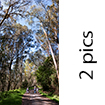
2 Good Old Nimitz
You know of course who Chester Nimitz is. "No"? Well, he is a man of the past, even if the most glorious past of American history. Chester was the US' first fleet admiral and commanded the Pacific Fleet during WWII. What business did I have with him on a cloudy day in early April?
The day before had been hermit's day. It had rained without interruption and I had felt no urge to leave my cosy studio. Fortunately, the rain had stopped towards evening and the morning after already looked promising (a false promise it turned out to be). Eager to exercise my legs, I took the rental car and headed towards a spot of nature close to Berkeley, called Tilden Regional Park.
As an aside, you would not expect that the Bay Area, which holds one of the largest congregations of mankind in the States, would contain any mentionable plots of undisturbed nature. But, in fact, you can find numerous such areas here, usually due to the need to maintain unspoilt watersheds. In chapters further along you will hear more about these islands of nature.
Tilden lies on the ridge of the Berkeley Hills, which shelter the town from the winds of the Great Central Valley. Mounting that ridge you feel on top of the world. To your East, your eyes can range far over hills gradually receding towards the Central Valley, only to be stopped by Mount Diablo, the highest mountain in the East Bay Area. To the West, the grand panorama of San Francisco, the Golden Gate and Mount Tamalpais unfolds before your eyes. And along the ridge a trail meanders back and forth, up and down, to give exercise to the eager hiker. This is no other than the famous Nimitz Trail, and I was hiking on it that morning. A true voyage down memory lane: this was Alice's and my favourite hiking trail way back in the seventies, when we had spent a year in Berkeley. The trail goes on and on, seemingly forever, but we always stopped our hike at a small hilltop, called Wildcat Peak. I had read somewhere that a commercial organisation had planted a "Redwood" grove along the peak. We looked and looked, but could never find it. Eventually it dawned on us that a small group of "Christmas" trees, located on the side of the hill, must be that grove. It turned out that these were baby Sequoiadendron Giganteum (Giant Sequoia) trees, still in their infancy.
So I started out my hike that morning full of expectations and curiosity. Would that small grove have survived the bay climate, so different from the varying weather conditions in the low Sierras, their natural habitat? To get the answer, I invite you to follow me on this walk along Nimitz trail, starting at a parking lot called Inspiration Point. Weather prospects did not look very promising at the outset. Lots of clouds in the sky, with Mount Diablo, the regional beacon towards the East, almost covered with grey. But this did not refrain me from starting the exercise.
Along the way I passed several groves of eucalyptus trees. From their prevalence you may be led to believe them to be native trees, thriving as they are in the Bay Area's mild climate. Nothing could be further from the truth. In the early 1900s, when the hills had been essentially deforested with all of the native coast redwood and pine groves gone, some clever businessmen got the idea to import quick growing eucalyptus from Australia, after having heard that this tree was commonly used there as building and pulping material.
Unfortunately, by importing the quickest rising of the species, it was overlooked that this specific variant was completely useless for either building or paper production. That notwithstanding, it thrived on the Berkeley Hills and soon outperformed all native trees there until, abruptly, there came a harsh winter in the early seventies, with snow and ice. This came as a surprise for the Australians, and an unheard of hardship for them, and most of them died off. But it bears witness to this tree's viability that new groves of substantial height have already repopulated the devastated areas.
Whilst the beginning of my journey was "blessed" with continuous drizz-ling, this eventually stopped and, after an hour's walk or so, I located rather easily in the beginning sunlight a sign I remembered, indicating "Berkeley Rotary Club Peace Grove". Unfortunately, the track going up to the grove on Wildcat Peak likened more a small brook than a path, but nothing could stop your eager wanderer, looking forward to the "gigantic" Sequoias. They did not disappoint me. The small group of sparsely planted "Christmas" trees had become a dense forest of pyramid shaped major trees of almost ten meters' height.
Fighting my way through the dense grove, I discovered that each Sequoia had, in line with the sign, been dedicated to a promoter of peace.
Glancing at the nametags adorning each tree, I suddenly was taken aback by one plate, on which shone in burnished letters the name of Edward Teller. With Edward having invented the hydrogen bomb, it will not surprise you that I was pondering on what grounds he had been chosen for this distinguished award. Maybe best to let sleeping dogs lie?
I had been on my way by then for an hour and a half already, so it was time to return. Fortunately, the sun kept me company almost back to the car, and soon I received my reward for hours of patient trodding: at an open stretch on the road, the panorama of San Francisco and the Golden Gate suddenly emerged from behind the clouds and reinvigorated this weary hiker.
During my return down to Berkeley, it started to rain again, but I happened by a nice spot for parking the car and taking some pictures of the Tilden Botanical Garden, beautified by the drizzle, with cherry and other blossoms eagerly awaiting to be captured on camera. This made it a perfect ending to the morning hike, even if the rain was continuing for the rest of this, as well as the following, day.






